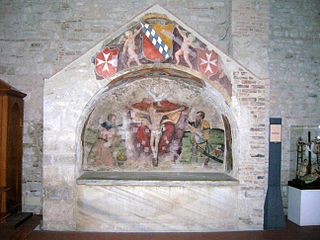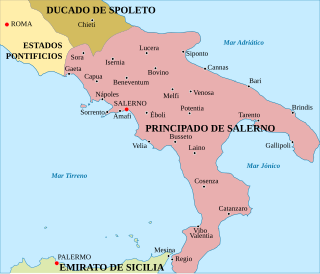
William I of Hauteville, known as William Iron Arm, was a Norman adventurer who was the founder of the fortunes of the Hauteville family. One of twelve sons of Tancred of Hauteville, he journeyed to the Mezzogiorno with his younger brother Drogo in the first half of the eleventh century (c.1035), in response to requests for help made by fellow Normans under Rainulf Drengot, count of Aversa.

Drogo of Hauteville was the second Count of Apulia and Calabria (1046–51) in southern Italy. Initially he was only the leader of those Normans in the service of Prince Guaimar IV of Salerno, but after 1047 he was a territorial prince owing fealty directly to the Emperor.

Humphrey of Hauteville, surnamed Abagelard, was the count of Apulia and Calabria from 1051 to his death.

Guaimar IV was Prince of Salerno (1027–1052), Duke of Amalfi (1039–1052), Duke of Gaeta (1040–1041), and Prince of Capua (1038–1047) in Southern Italy over the period from 1027 to 1052. He was an important figure in the final phase of Byzantine authority in the Mezzogiorno and the commencement of Norman power. He was, according to Amatus of Montecassino, "more courageous than his father, more generous and more courteous; indeed he possessed all the qualities a layman should have—except that he took an excessive delight in women."

Pandulf IV was the Prince of Capua on three separate occasions.

The Duchy of Amalfi or the Republic of Amalfi was a de facto independent state centered on the Southern Italian city of Amalfi during the 10th and 11th centuries. The city and its territory were originally part of the larger ducatus Neapolitanus, governed by a patrician, but it extracted itself from Byzantine vassalage and first elected a duke in 958.
Guaimar III was the Lombard prince of Salerno from around 994 to his death. Under his reign, Salerno entered an era of great splendour. Opulenta Salernum was the inscription on his coins. He made Amalfi, Gaeta and Sorrento his vassals and annexed much of Byzantine Apulia and Calabria.

Pilgrim was a statesman and prelate of the Holy Roman Empire. In 1016 he took charge of the chancery of the Kingdom of Italy, and became the first archchancellor in 1031. In 1021 he became Archbishop of Cologne. For his part in the imperial campaign against the South Italian principalities in 1022, the chronicler Amatus of Montecassino described him as "warlike".
Richard Drengot was the count of Aversa (1049–1078), prince of Capua and duke of Gaeta (1064–1078).

Tedald, of the House of Canossa, was the count of Brescia from 980, Modena, Ferrara, and Reggio from 981, and Mantua from 1006. He used the title of margrave because of his vast comital holdings and their frontier nature. His family's seat was Canossa and he was the son of Adalbert Azzo of Canossa who had supported Otto I against Berengar of Ivrea and Adalbert of Ivrea. His rise was largely due to his loyalty to the Ottonian Dynasty.
Pandulf V was the count of Teano and prince of Capua (1022–1026). That he was related to the ruling dynasty of Capua seems likely, but is uncertain. He was installed at Capua by Pilgrim, Archbishop of Cologne, who besieged Capua and deposed the current prince, Pandulf IV was imprisoned in Germany. The Emperor Henry II officially granted the principality to Pandulf V in 1023 and associated his son John with him as co-prince.
Laidulf was a son, probably the youngest or second youngest, of Pandulf Ironhead. He probably never expected to inherit much, especially with his many cousins vying for their rightful inheritances. He was the Count of Teano, and was implicated in the assassination of his brother, Landenulf, and the archbishop of Benevento in 993.

The Principality of Salerno was a medieval Southern Italian state, formed in 851 out of the Principality of Benevento after a decade-long civil war. It was centred on the port city of Salerno. Although it owed allegiance at its foundation to the Carolingian emperor, it was de facto independent throughout its history and alternated its allegiance between the Carolingians and their successors in the West and the Byzantine emperors in the east.

The Principality of Capua was a Lombard state centred on Capua in Southern Italy. Towards the end of the 10th century the Principality reached its apogee, occupying most of the Terra di Lavoro area. It was originally a gastaldate, then a county, within the principality of Salerno.

The Battle of Ménfő was an important battle in the early history of the Kingdom of Hungary. Fought in 1044 at Ménfő, near Győr, between an army of mostly Germans and Hungarians (Magyars), it was a victory for the Germans and thus for Westernising influences in Hungary.

The County of Apulia and Calabria, later the Duchy of Apulia and Calabria, was a Norman state founded by William of Hauteville in 1043, composed of the territories of Gargano, Capitanata, Apulia, Vulture, and most of Campania. It became a duchy when Robert Guiscard was raised to the rank of duke by Pope Nicholas II in 1059.
Richard of Hauteville was a noble knight of Hauteville family, the conquerors of South Italy during the 11th century.

The Cambridge Medieval History is a history of medieval Europe in eight volumes published by Cambridge University Press and Macmillan between 1911 and 1936. Publication was delayed by the First World War and changes in the editorial team.
Events during the year 1106 in Italy.
Maud of Apulia was a member of the Norman D’Hauteville family and a daughter of Robert Guiscard and his second wife Sikelgaita, a Lombard princess, the daughter of Guaimar IV, Prince of Salerno. She was also known as Mahalda, Mahault, Mafalda and Matilda. She was the wife of Ramón Berenguer II, and thus Countess of Barcelona (1077–1082). After her husband’s death, she remarried Aimery I, the Viscount of Narbonne (1086–1108).











